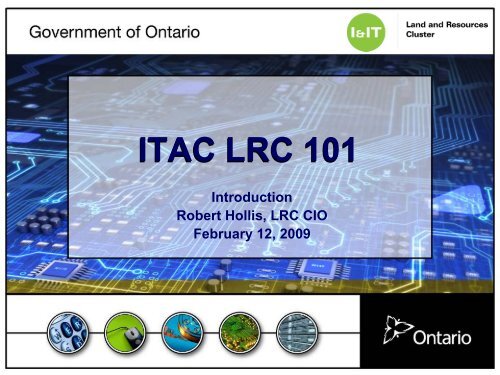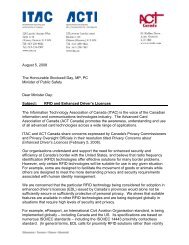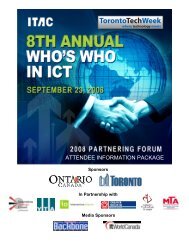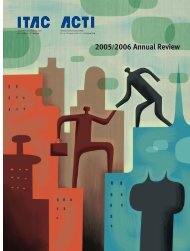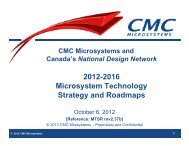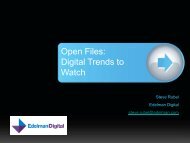LRC 101
LRC 101
LRC 101
Create successful ePaper yourself
Turn your PDF publications into a flip-book with our unique Google optimized e-Paper software.
ITAC <strong>LRC</strong> <strong>101</strong>IntroductionRobert Hollis, <strong>LRC</strong> CIOFebruary 12, 2009
Welcome to <strong>LRC</strong> <strong>101</strong>2• Thanks for joining us today to learn about the Land andResources I&IT Cluster (<strong>LRC</strong>)• The <strong>LRC</strong> serves the Ministries of:– Aboriginal Affairs,– Agriculture, Food and Rural Affairs– Environment– Natural Resources, and– Northern Development and Mines
Background3• The <strong>LRC</strong>, like many clusters, gets calls and e-mails fromvendors on a regular basis• Vendor’s products or services often have no connection tothe needs of the <strong>LRC</strong> and the ministries that it serves• The <strong>LRC</strong> would like to take thisopportunity to inform vendorsof the programs and servicesoffered by its five ministries andthe challenges they face
Goals of <strong>LRC</strong> <strong>101</strong>4• The <strong>LRC</strong> is looking for focused ITsolutions from the vendor communitythat are a match to the uniquebusiness requirements of its ministries• We want to learn from yourexperience and/or solutions servingpublic sector ministries ordepartments in other provinces, statesor countries to solve our challenges
Connecting5• You will have an opportunity to ask questions after eachpresentation and meet one-on-one at the end of thesession with the Land and Resources Cluster presentersand subject matter experts• We will follow up with vendorswhose products or serviceshave the most potential toaddress ministry specificneeds over the coming years
Agenda for today61. Cross Cluster Projects – Ted Volpe (mobile computing) andRandy Douglas (CMDB and telecom)2. Ministries of Aboriginal Affairs; Agriculture, Food and RuralAffairs; and Environment – Igor Solesa3. Ministry of Natural Resources – Ted Volpe (natural resourcesmanagement) and Bruce Wurtele (GIS) for Scott Christilawand Frank Matejka for Carol Smith (forests)4. Ministry of Northern Development and Mines – Franco Merlinofor Carol Smith5. One-on-one follow up – Vendors talk to presenters and subjectexperts about the <strong>LRC</strong>’s challenges
ITAC <strong>LRC</strong> <strong>101</strong>Cross Cluster Priority ChallengesFebruary 12, 2009
Cross Cluster Challenges81. Mobile Computing2. Configuration Management Database3. Alternate Bandwidth Solutions for Far North4. Wireless LAN5. Radio6. Videoconferencing
1. Mobile Computing Overview9• There are significantopportunities to help thefield work force work moreefficiently and to improveresource managementand customer service• We want solutions that give government staff secureconnections from various remote and mobile locations(hardware, telecommunications, security, software,device management)
1a. Scope10• <strong>LRC</strong> ministries want to use more mobile computingtechnology in field work• Roughly 1,000 workers within those ministries dofieldwork• 75% use paper to collect information and writetickets/reports• The other 25% use mostlyinefficient/legacy systems,and do not take fulladvantage of currentopportunities
1b. Challenges11• Field staff operate most frequently in adisconnected environment• Wireless data transmission costs are high• Hardware must:– be easy to carry & use– have large screens– withstand rugged environments– be powerful– offer other specialised requirements• Entire system must be highly secure• Some business areas need to be educated about how thistechnology can help them work more efficiently• Cultural shift for staff
1c. Current Status and Next Steps12• Some projects are using mobile computingtechnology, but different approaches are being taken• We’re developing a target technology architecture anda strategy to expand the use of mobile computing inan integrated and standardised manner• We’re working with businessareas to create pilot projectsto develop or improve mobilesolutions
2. Overview of Configuration Management Database13• The <strong>LRC</strong> needs to implement a proper ConfigurationManagement Database• The CMDB needs to house application, IT Infrastructure,network and end user asset information• The <strong>LRC</strong> needs this tool to assess potential impacts ofchanges occurring within our IT and Telecommunicationsinfrastructure• Network and end user asset information would also help uscomplete desk top refreshes, office relocations, andresolve billing discrepancies
2a. Project Scope14• A CMDB encompassing a broad range of data including:Application, IT infrastructure, network, cabling facilities andend user asset informationMETRICS• <strong>LRC</strong> Change Management currently processes more thanover 100 IT production changes each month• Over 50 WAN/LAN changes per year• Over 20 major office relocations/refreshes per year
2b. Project Challenges15• Identifying the right tool that bestmeets our business requirements(off the shelf or custom built?)• Implementing the database withaccurate information – anextensive audit will be required• Developing a process to maintain the accuracy of theinformation on a go forward basis. Activities from fiveministries will be engaged in one common process
2c. Current Status and Next Steps16• Define requirements• Submit RFI• Submit RFP• Award project• Develop a project plan andcharter• Implement
3. Alternate Bandwidth Solutions for Far North Overview17• <strong>LRC</strong> has many clients that operate in the Far North. Theseclients continue to face bandwidth issues• <strong>LRC</strong> uses some satellite ISPservices, but is very interestedin learning of other possiblesolutions or projects• Communications is critical formany of our program areasincluding fire prevention,enforcement, and emergencymanagement organizations
4. Wireless LAN Overview18• The demand for this service is increasing. We’re interestedin proposals for cost effective high quality solutions thatmeet all GO ITS security standards• The OPS continues to move forward with its Greenstrategy toward a paperless mode of operation• Wireless LAN provides seamless access to the OPSnetwork having to search for a LAN connection from oneoffice location to another
5. Radio Overview19• The OPS currently has two separate radio systems. (lowband and high band). We’re interested in working withvendors to possibly integrate these two networks• It is extremely difficult and expensive to maintain twoseparate communication networks• One common network wouldalso let user groupscommunicate with each otherduring an emergency situation– OPP with MNR AFFM (Fire)– OPP with MNR Enforcement
6. Videoconferencing Overview20• The <strong>LRC</strong> is interested in information on emergingvideoconferencing technologies• Desktop technologies• High Definition/Quality of Servicesolutions• Room ergonomics• Web based reservation systemswhich could include onlineboardroom bookings etc.
ITAC <strong>LRC</strong> <strong>101</strong>Business Solutions Services – Central/WestOverviewFebruary 12, 2009
22ITAC <strong>LRC</strong> <strong>101</strong>Ministry of Aboriginal AffairsOverview
Ministry Mandate23• Ministry of Aboriginal Affairs (MAA)’s vision:“Working together for a healthy, prosperous and just futurefor Aboriginal people”• MAA negotiates and resolves land claims and providesAboriginal policy development and relationship expertise• MAA is responsible forleading mandatedcorporate Aboriginalinitiatives and supportingministries in their areasof specific responsibilities
Business Priorities24• Lead strategic policy and planning to ensureOPS policies and programs contribute to beneficial,sustainable change within Aboriginal communities• Resolve land claims and address rights toreconcile Crown/Aboriginal interests on land issuesand improve certainty over lands and resources• Strengthen relationships to support collaborativeapproaches toward mutually beneficial solutionsamong all parties involved in Aboriginal affairs• Leverage information and knowledge to ensure ministries have themost current information; to gather and retain information andknowledge arising from external, formal, and informal relationships; andto increase the public’s awareness of Aboriginal affairs in Ontario
Key I&IT Initiatives25• Continue to work on the Aboriginal Information Service, includingintegrating and managing data, develop collaboration tools/portalthat support relationship management and integrating LandClaim Information• Develop Joint Land Claim Registry (ongoing)• Investigate workflow / casemanagement for negotiations /land claims files• Implement / stabilize corporatebusiness solutions (ongoing)• Enterprise Information Management (EIM) Implementation
26ITAC <strong>LRC</strong> <strong>101</strong>Ministry of Agriculture, Food and Rural AffairsOverview
Ministry Mandate27• The Ontario Ministry of Agriculture, Food and RuralAffairs' (OMAFRA) vision is:– A strong agri-food sector that is integral to Ontario'seconomy and contributes innovative solutions to protectthe environment, to provide safe and nutritious food, topromote the bio-economyand to support the healthand well-being of Ontarians
Business Priorities28• Enhancing environmental health• Emergency preparedness andmanagement• Enhancing food safety• Next generation agri-food policy• Accelerating investments to buildmarkets• Rural economic development and policy coordination
Key I&IT Initiatives29• Build a Food Safety Portal• Implement a Food Safety Decision Support System(FSDSS)• Transform Agricorp• Develop an Animal HealthStrategy and system
30ITAC <strong>LRC</strong> <strong>101</strong>Ministry of the EnvironmentOverview and Priority Challenges
Ministry Mandate:31• The Ministry of the Environment is responsible for protectingclean and safe air, land and water to ensure healthycommunities, ecological protection and sustainable developmentfor present and future generations of Ontarians• Compliance based ministry:– The ministry manages a comprehensive legislative and regulatoryframework that keeps up with emerging science and developsleading-edge policy to incorporate the newest and best approachesto environmental management– The ministry also sets standards for key pollutants to protecthuman health and the environment and monitors Ontario’senvironment and analyze incoming data
Business Priorities32• Climate change and protecting Ontario’s air• Protecting Ontario’s water• Waste diversions• Brownfields reform• Effective compliance andenforcement
Key I&IT Initiatives33• Hazardous Waste real time tracking and management• Focus on place based information and business intelligencereporting capabilities• Focus on enterprise ETL, data warehousing/marts• Support the Government’s “Open for Business” agenda, includingearly adoption of the single business number and commonregistration• Enterprise Business Architecture (environet modernization)• Implementation of Brownfield reforms• Improve field inspection data capture and mobile computing
Priority Challenge Projects34• Real Time tracking of hazardous waste movement• Tight integration between Cognos BI and ArcGIS tosupport:– Real time spatial visualization of data (BI to GIS)– Enable Map based queries toderive BI reports (GIS to BI)
1. Hazardous Waste Tracking Overview35• The Ministry’s Hazardous Waste program tracks theshipment/movement of hazardous waste materials inthe province• The ministry would like to track hazardous waste fromgenerators through to disposal or recycling plant(receivers)
1a. Project Scope36• Tracking requirements include real time location ofmaterials as they are being transported by carriers,including truck to truck transfers• Solution may need to consider integration capabilitieswith hazardous waste haulers and receivers• Solution will need to track the Generator, Carrier andReceiver of the materials (all three parties must beregistered with the Ministry)• System will be used to assess fees based on type andquantity of materials being transported and disposed
1b. Project Challenges37• Costs – including possible use of hand held devices• Use of electronic equipment, including hand helddevices may not be adopted by industry• Minimal disruption to existing lines of business,specifically Carriers andReceivers– Larger industry players useexisting systems to scheduleand manage their pick-up anddelivery of materials
1c. Current Status and Next Steps38• MOE is evaluating a number ofpolicy and regulatory changes• This includes looking ahead tothe future state of the HazardousWaste program– Business Architecture and business process engineering willneed to be conducted to align Ministry expectations withthose of the industry (Generator, Carriers, Receivers)• Solution acquisition / development will occur inapproximately one year
2. Business Intelligence and GIS Integration Overview39• The Ministry has invested in a business intelligencereporting environment using Cognos (8.x)• Reporting focus has expanded to include geospatialrepresentation of data being mined• The <strong>LRC</strong> has established arobust geospatial reportingenvironment via the LandInformation Ontario (LIO)infrastructure (using ESRI– ArcGIS products)
2a. Project Scope40• There is a need to establish tight integration betweenthe two environments in order to enable dynamicmapping and/or BI query capabilities– Ability to reflect results in real time in both environments as queriesare made either through Cognos or LIO (ArcGIS)– Ability to pass query parameters between the two environments– Ability to display reporting and mapping capabilities in a single viewon screen• Need for a robust Extract, Transform and Load (ETL)tool to establish and manage reporting data marts andwarehouses
2b. Project Challenges41• BI to GIS Integration– Different technology platforms (Cognos / ESRI)– Performance of generating maps• ETL Tool– Support for handlinggeospatial data
2c. Current Status and Next Steps42• BI to GIS Integration– RFS for solution drafted and in process of beingpublished to VOR community• ETL Tool– RFP for solution draftedand to be issued in newfiscal year
ITAC <strong>LRC</strong> <strong>101</strong>Business Solutions Services – East and NorthMinistry of Natural ResourcesPriority ChallengesFebruary 12, 2009
Ministry Mandate44• The Ministry of Natural Resources manages andprotects Ontario’s natural resources for wise useacross the province• The ministry is the steward of Crown lands and waterscovering 87 per cent ofthe province and all of theprovincial parks, forests,fisheries, wildlife, mineralaggregates, petroleumresources in Ontario
MNR Business45• Promotes healthy, sustainable ecosystems• Conserves biodiversity (the variety oflife on Earth)• Conducts scientific research and appliesthe findings• Develops resource management policies• Manages Ontario’s crown land• Promotes economic opportunities in theresource sector• Enhances opportunities for outdoor recreation• Manages geographic information
Key I&IT Initiatives46• Ensure new technologies meet the requirements of MNR’sInformation Management (IM) Strategy• Update and integrate the Land Information Ontario (LIO)Geographic Information System (GIS) applications• Refresh MNR’s current GIS technology• Implement recommendations in Low Band Engineering Study• Improve the Parks Reservation and Registration service• Upgrade the Fish and Wildlife Licensing system• Develop an extranet content management system
Priority Challenge Projects471. Licensing Systems2. Rule Based Draw Systems3. Storage and transfer ofimagery data4. Inventory ManagementSystem5. Communications Log
1. Licensing Systems Overview48• The current LicensingSystems will be replacedin the near future• The Systems licencehunters and fishers andtake payment
1a. Scope49• The system needs to be capable of taking personalinformation, taking payments and issuing theappropriate licences• Licence issuers must be provided with equipment andmaintenance [computers,magnetic stripe reader andprinter(s)]• MNR staff and licenceissuers require technicalsupport 24/7
1b. Challenges50System solution must:• Allow licence sales over threeservice channels (in-person, via theinternet and by automated phonesystem)• Service license providers scatteredall over province• Allow licensees to print e-licence on their home printer• Protect personal information
1c. Current Status and Next Steps51• Current systems are outdated and legacy• An RFP for new system to be issued in near future
2. Draw System Overview52• MNR Draw Systems needto be replaced• These systems are usedto allocate huntingopportunities
2a. Scope53• Take personal information from licensing systems,allocate appropriate tag (could include issuance)• Incorporate business rules into draw system, basedon past draw success, areas, etc.
2b. Challenges54System solution must:• Combine randomnesswith many complex,specific rules• Allow different rules fordifferent kinds of draws• Create tags on special, rugged media• Protect personal information
2c. Current Status and Next Steps55• There are currently four different systems• The current systems are outdated and legacy• Will likely want to combine all of the current systemsinto one
3. Storage and transfer of imagery data Overview56• MNR coordinates imagery acquisition projects formultiple partners across the province• This includes detailed satellite and orthophotographyproducts• Large data volumes (hundredsof TB, growing to 1 PB inseveral years)
3a. Scope57• Transferring large imagery products• Storage and archiving imagery products
3b. Challenge58• Need efficient and cost-effective technologies for datatransfer & storage.– Cost-effective storage technology– Long transfer & retrieval times– Data transfer method & technologyExternalHardDrivesNearlineTapeSolutionCurrent+ SANStorage
3c. Current Status and Next Steps59• Advanced high-speed networks for data transfer• Mobile, large volume online storage devices• Low cost, nearline storage
4. Inventory Management System Overview60• An inventory management system is needed to get moreaccurate information on forest fire suppression equipmentfaster, so that less time and work is needed to maintainaccurate records• This system is needed to track a widevariety of equipment including, but notlimited to, aerial ignition helitorchs,digital cameras, generators, handheldGIS and GPS, bear fencing, chainsaws,portable showers, tents, trailers,transceivers and all-terrain vehicles
4a. Scope61• The solution will be used to help the ministry in inventorycontrol and logistics• The system should be scalable, non-proprietary andflexible, so it can eventually be expanded and used for all18,000 pieces of equipment• It should have the capability to read a warehouse ofequipment in 30 minutes• The information provided by the equipment is expected tobe 100% accurate
4b. Challenges62System solution must:• Be able to survive the fire fightingenvironment including heat, cold,vibration, impact, light and fumes• Be small enough to be placed wherethey will not be easily damaged orinterfere with the longevity andfunction of equipment• Not interfere with or be disrupted by otherequipment found in airports, phone systems andpocket companion phones
4c. Current Status and Next Steps63• An RFID pilot project ended in 2006 without thechallenges being fully addressed• The Aviation and Forest Fire Management Branch ofMNR is still interested in an IT solution and is willingto initiate a procurementprocess if suitablyfield-tested technology canbe found
5. Communication Log Overview64• An automated radiocommunications log isrequired to provide consistentand accurate flightcommunications information• The system would track andrecord a variety of information including pilot call-ins,pilot duty time, journey logs and flight manifests
5a. Scope65• The system will be used to provide mandatory flightwatch• It should be scalable, non-proprietary and flexible toallow for future expansion• It should have a usercustomizableinterfaceto meet the demands ofdifferent target groups• The system should becapable of setting alerts
5b. Challenges66System solution needs to be:• Integrated withComputerTalkIVR technology• Integrated with existingAFFMB systems, bothcustom-built and off-the-shelf
5c. Current Status and Next Steps67• AFFMB currently uses a number of manualprocesses, written log books and semi-automatedstand-alone tools• Efforts are underway tostreamline processes andMNR would be interestedin any proven technologysolutions
ITAC <strong>LRC</strong> <strong>101</strong>Business Solutions Services – NorthMinistry of Northern Development and MinesPriority ChallengesFebruary 12, 2009
Ministry Mandate69• The Ministry of Northern Development and Minesserves northern Ontario and the province’s mineralsindustry• We deliver provincial government programs and servicesin the north that help our economy and our communitiesprosper and grow and represent northern and mininginterests at Queen’s Park
Business Priorities70• MNDM’s business priorities are outlined in theNorthern Prosperity Plan (NPP), and include:– Strengthening the north and its communities– Listening to, and serving Northernersbetter– Helping the north to compete globally– Providing new opportunities– Modernizing public stewardship of mining– Strengthening the northern economy– Investing in northern infrastructure
Key I&IT Initiatives71• Modernizing IT systems for the Northern OntarioHeritage Fund Corporation• Identify what IT needs to do to adapt to upcomingchanges to the Mining Act
Priority Challenge Projects721. Online Client Application Front Ends2. Create a financial system for theNorthern Ontario Heritage FundCorporation3. Reviewing how changes to theMining Act impact IT
1. Online Client Application Front Ends Overview73• Review the internal applications that could benefitfrom Internet facing front ends that will feed multipleapplications behind a firewall• We want clients to be able tosubmit applications online, andfor MNDM to review the statusof applications and transferinformation to internal systemsfor them to be validated andprocessed
1a. Project Challenges74We need to be able to:• Quickly develop web-based interfaces thatcommunicate with existing internal applications• Securely import and export information to internalapplications• Manage more than5,000 client accounts• Find a commercial offthe shelf (COTS) solution
1b. Current Status and Next Steps75• Now still at the concept stage• We’re beginning a feasibilitystudy to look at options
2. Create a financial system for the Northern OntarioHeritage Fund Corporation76• NOHFC needs an intuitive and easy to managesystem to track the financial components of fundedprojects and support the day-to-day management andreporting of operations• The system will provide financial management forvarious programs as well asaccounting and reportingrequired by the NOHFC asa Crown Corporation of theOntario Government
2a. Project Challenges77• We need a single vendor who can provide a COTS integrated“Financial Management System” that:– manages loans– manages contributions and grants– handles day-to-day accounting– provides financial reporting• The solution needs to be flexible so that secure interfaces cancommunicate with internally developed applications in industrystandard formats• The system has to import existing financial information from anexisting accounting system
2b. Current Status and Next Steps78• RFP anticipated on MERX in February 2009• Project will begin this spring
3. Reviewing how the Mining Act changes impact IT79• The Mining Act of Ontario is currently being reviewed andmodernized• MNDM/<strong>LRC</strong> will review the changes tolegislation/regulations, and determine requirements for newapplications, modifications and enhancements to existingapplications, and effects on infrastructure• MNDM/<strong>LRC</strong> will identify impacts of other proposedlegislation and regulatory changes to Acts beyond theMining Act
3a. Project Challenges80• All modifications must becompleted within two to fouryears• A number of complex, multithematicdatasets needto be integrated• All applications must align with other systems, includingsome that may be changing at the same time as a result ofmodernizing the Act
3b. Current Status and Next Steps81• We have finished reviewing land acquisition methods inother provinces• We have acquired new, accurate topographic andtransportation data and are now incorporating it intocurrent systems• Current mining land tenure data needs to be reviewed toalign it with accurate base data• Next steps will be determined based on the results of theMining Act Modernization process
Contact Information for the <strong>LRC</strong>82• Ministry of Aboriginal Affairs, Ministry of Agriculture, Food andRural Affairs and Ministry of Environment – Igor Solesa(igor.solesa@ontario.ca)• Ministry of Natural Resources – Scott Christilaw(scott.christilaw@ontario.ca) for natural resources managementand GIS and Carol Smith (carol.smith1@ontario.ca) for forests• Ministry of Northern Development and Mines – Carol Smith• Cross Cluster Projects – Ted Volpe (ted.volpe@ontario.ca) formobile computing and Randy Douglas(randal.douglas@ontario.ca) for CMDB, telecom and video
ITAC <strong>LRC</strong> <strong>101</strong>Thank you


